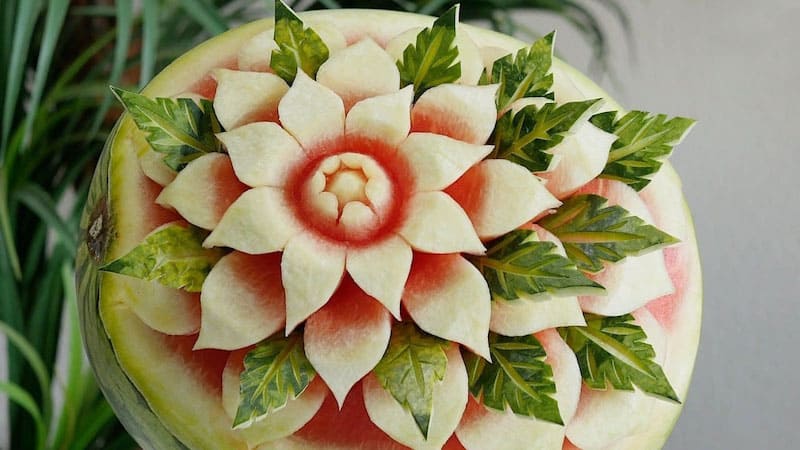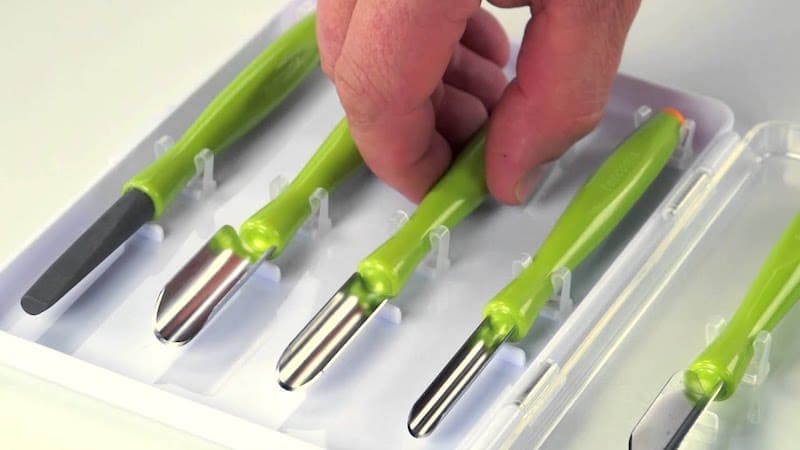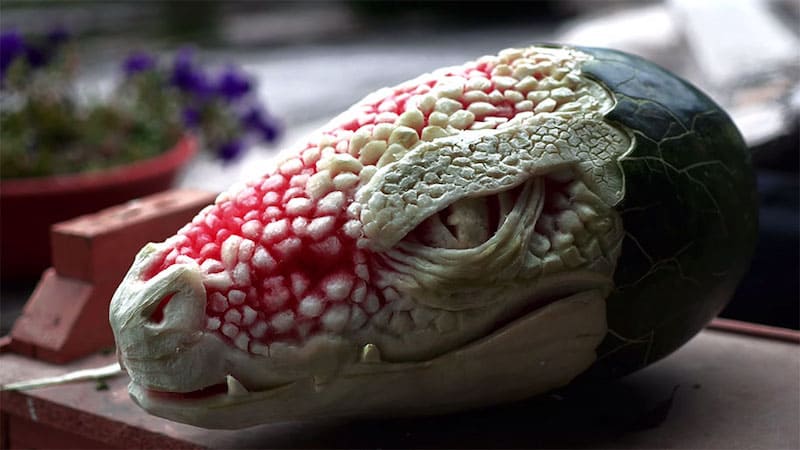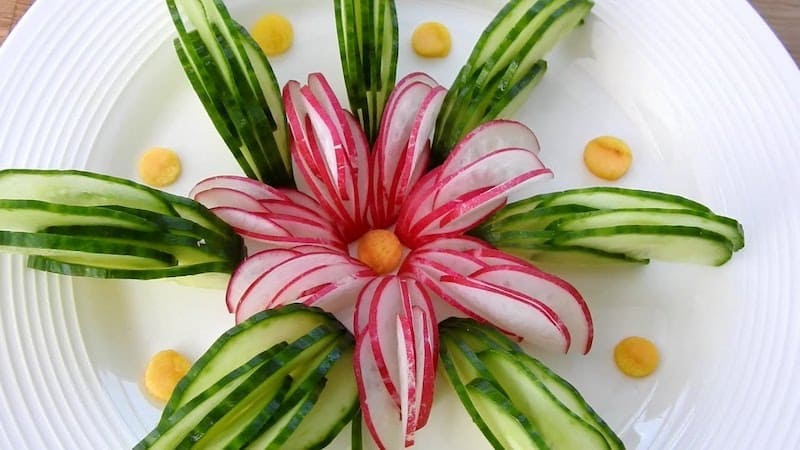
In a culinary world awash with colors and flavors, there's a form of food artistry that bridges the divide between food preparation and the talent of a sculptor: Fruit Carving. At first glance, you might think of this art form as simply slicing a watermelon or hollowing out a pineapple. However, with a splash of imagination and talented fingers, an artist can transform just about any fruit or vegetable into a radish flower, an arrangement of citrus peels, an apple swam or pineapple boat.
In this article you will learn about the ancient tradition of fruit carving that grace the tables of Thai royalty, ceremonial displays during Japanese festivals and carver competitions. Each slice, each cut, each twist and turn of the knife is a homage to traditions passed down through generations. Each piece of fruit, with its unique shape and color, presents a canvas of nature like no other. Where an apple's deep red hue might inspire thoughts of a sunset, a honeydew's soft green skin might be sculpted into a rolling hillside.
As we peel back the layers of food art, you soon realize that fruit carving is not just about creating something beautiful to look at, it's a meditative dance, where the artist transforms their subject into something that resembles what they have imagined in their minds eye.

When you explore the history of fruit carving, you'll discover that it has deep roots in eastern cultures. The Thai fruit carving tradition, known as Kae Sa Luk, is one of the earliest documented forms of fruit art. Dating back to the 14th century, it was a skill reserved for the women of the royal palace. They would carve intricate floral patterns into fruits and vegetables, creating exquisite servings for the royal table.
Japanese fruit carving, often referred to as Mukimono, is another distinct style that gained prominence in the 16th century. This style emphasizes simplicity and minimalism, focusing on the natural beauty of the fruit. Mukimono carvings often feature intricate designs that are carefully etched into the skin of the fruit of a watermelon for example, creating a subtle yet stunning effect.
From these traditional roots, fruit carving has evolved and spread across the globe. Regardless of the style or technique, the purpose remains the same - to transform simple fruits into artistic masterpieces that elevate culinary gatherings at a table.
Just as a painter needs their brushes, fruit carving requires its own set of tools and knives. A good carving set is essential to achieve precise cuts and intricate details. These sets usually include different types of knives, each designed for a specific purpose. For instance, a paring knife is used for peeling and making small cuts, while a bird’s beak knife is perfect for creating intricate designs and curved cuts required for skin carvings and pineapple boats.
Other tools play a vital role in fruit carving. A melon baller, for example, can be used to scoop out portions of the fruit, while a channel knife helps create grooves and channels. A carving fork is handy for holding the fruit steady, and a zester or grater can be used to create texture and patterns on the skin of a fruit or vegetable.
Carving tools are an extension of a fruit carvers’ hands. The quality and sharpness of these tools can greatly affect the detail and precision of a carving.

Mastering knife skills is a crucial aspect of fruit carving. Precision, control, and safety are integral to this culinary art form. To start, familiarize yourself with the different types of knives and their uses. Practice basic cuts such as slicing, dicing, and julienne in throw away fruit until you're comfortable handling the different types of knifes.
One you have mastered basic knife skills, start working on more complex cuts. Try creating different shapes and patterns, such as floral patterns or citrus peel designs. Remember that practice makes perfect. The more you carve, the more your knife skills will improve.
Safety is paramount when handling knives. Always ensure your hands are dry to prevent the knife from slipping. Hold the fruit firmly but gently, and always cut away from your body. Remember, fruit carving is about patience and precision, not speed.
Fruit carving techniques range from basic to advanced, depending on the complexity of the design. Let's start with the basics. The first step in any fruit carving is to choose the right fruit. Firmer fruits like watermelons, apples, and pineapples are easier to carve, hold their shape well and last longer.
Next, sketch out your design on the fruit using a marker. This acts as a guide and helps ensure precision. Once your design is marked, use your carving tools to carefully cut along the lines. Start with broad cuts to shape the fruit, then move on to detailed work selecting the different types of knives as you need them.
As your skills improve, you can start experimenting with more complex designs and techniques. These might include creating 3D sculptures, carving multiple fruits into a arrangement, or even incorporating elements like led lights into your carvings. Remember, there are no limits to what you can create with fruit carving and your imagination!
Creating floral patterns is the standard in fruit carving, with representations of flowers like roses, lilies, and chrysanthemums frequently recreated in fruits like papaya, mango, apples, carrots, and strawberries. The radish flower is a popular carving, where the humble radish is transformed into a delicate and intricate edible flower. Citrus peel designs are also a common sight in fruit carving, with the inside outside colors of the peel adding a touch of brightness and depth to the carving.
Creating these patterns requires a keen eye for detail and a steady hand. The trick is to observe the natural characteristics of the fruit and use them to enhance your carving. For example, the gradient colors of a watermelon rind can be used to create depth and dimension in a floral carving.
With practice and patience, you can master these popular fruit carving patterns and create your own unique designs.
Fruit carving is all about transforming everyday fruits into extraordinary masterpieces. A melon carving can be a stunning centerpiece for a summer gathering, while a watermelon lantern can add a magical touch to a nighttime event. Apple swans, with their elegant curves and delicate details, make a beautiful garnish for that special gourmet meal.
Creating these masterpieces requires both skill and creativity. To carve a melon, you'll need a sharp knife to cut through the tough skin and a melon baller to scoop out the flesh. For a watermelon lantern, you'll need to hollow out the watermelon and carve designs into the rind. An apple swan requires precision and a steady hand to carve the intricate details.

Remember, fruit carving is not just about the end product; it's about the process. Enjoy the journey of creating your masterpiece, and don't be afraid to experiment with different designs, techniques and a little meditation before you start.
While fruit carving is more popular, vegetable carving is equally impressive and offers its own set of possibilities. Like fruit carving, vegetable carving involves transforming vegetables into artistic creations. This can range from simple garnishes to complex centerpieces.
Vegetables offer a wide array of colors, textures, and shapes to work with. Carrots, cucumbers, and radishes are commonly used because of their firm texture and vibrant colors. More complex carvings like those often displayed in Japan, might include pumpkins, eggplants, or bell peppers.
One popular vegetable carving is cucumber lace, where a cucumber is delicately carved into a beautiful lace pattern. Other examples include daikon radish flowers and carrot leaf designs. Whether you're carving fruits or vegetables, the goal is the same - to showcase your culinary creativity and enhance the visual appeal of the event and what is being served.

If you're interested in learning the art of fruit carving, workshops and classes are a great way to start. These provide hands-on experience under the guidance of experienced carvers. There you will learn basic carving techniques, knife skills, and various carving patterns.
In addition to physical classes, there are also plenty of online resources available. From video tutorials to step-by-step guides, you can learn at your own pace from the comfort of your home. Consider joining a fruit carving community or forum to share your creations and learn from others.
Remember, fruit carving is a skill that takes time to master. Don't be discouraged if your first few attempts look like crap. Keep practicing, keep learning, and most importantly, keep enjoying the process.
One of the best things about fruit carvings is that they're not just beautiful to look at - they're also edible! Fruit carvings make fantastic decorations for any occasion. They can be used as centerpieces at parties, garnishes for gourmet meals, or even gifts for special occasions like weddings.
Imagine serving a fruit salad in a beautifullycarved pineapple boat, or garnishing your cocktail with a delicate citrus peel design. Not only do these carvings enhance the visual appeal of your dishes, but they also add a touch of elegance and creativity for the occasion.
Remember, the purpose of fruit carving is to enhance the dining experience. So don't just create your carvings - use them to bring joy and beauty to people that will enjoy your meals.

Fruit carving is a wonderful way to showcase your culinary food art. From pineapple boats to cucumber lace, the possibilities are endless. Each piece you create is a reflection of your skill, creativity, and passion for food and entertaining.
Sharing your creations is a great way to inspire others and spread the joy of fruit carving. Whether it's through social media, a blog, or a local art exhibition, don't be shy to show off your culinary masterpieces.
Remember, every artist started as a beginner. Don't be discouraged by comparisons or criticism. Instead, use them as motivation to improve and continue creating. Your journey in fruit carving is unique, and every masterpiece you create will be a testament to your progress.
Ready to transform your land into a high-yield, sustainable farm? Let Crop Circle Farms design and build a custom, low-impact, and water-efficient farm tailored to your needs. Double your income and cut your costs in half! Contact Us
Help us expand our mission to revolutionize agriculture globally. We are seeking partners to implement Crop Circle Farms to feed people in need. Together, we can build scalable food production systems that save water, reduce costs, and feed thousands of people. Contact Growing To Give